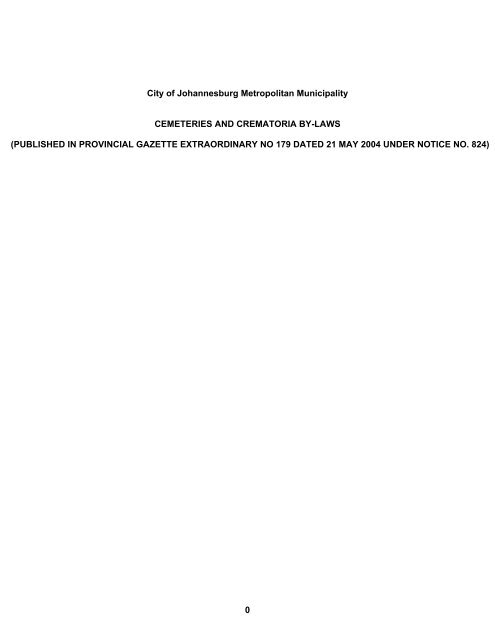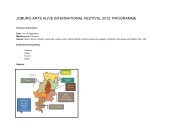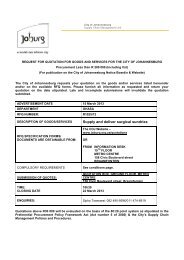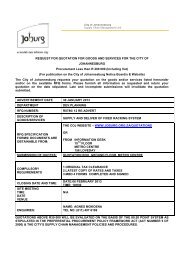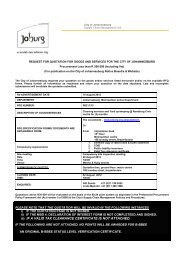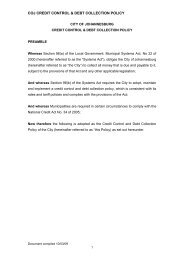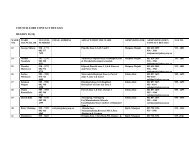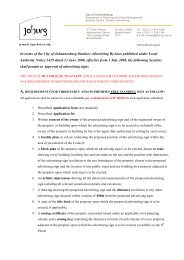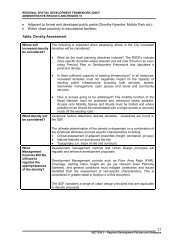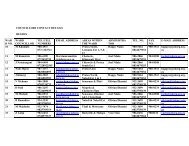CEMETERIES AND CREMATORIA BY-LAWS - Joburg
CEMETERIES AND CREMATORIA BY-LAWS - Joburg
CEMETERIES AND CREMATORIA BY-LAWS - Joburg
Create successful ePaper yourself
Turn your PDF publications into a flip-book with our unique Google optimized e-Paper software.
City of Johannesburg Metropolitan Municipality<br />
<strong>CEMETERIES</strong> <strong>AND</strong> <strong>CREMATORIA</strong> <strong>BY</strong>-<strong>LAWS</strong><br />
(PUBLISHED IN PROVINCIAL GAZETTE EXTRAORDINARY NO 179 DATED 21 MAY 2004 UNDER NOTICE NO. 824)<br />
0
CITY OF JOHANNESBURG METROPOLITAN MUNICIPALITY<br />
<strong>CEMETERIES</strong> <strong>AND</strong> <strong>CREMATORIA</strong> <strong>BY</strong>-<strong>LAWS</strong><br />
The Municipal Manager of the City of Johannesburg Metropolitan Municipality hereby, in<br />
terms of section 13(a) of the Local Government Municipal Systems Act, 2000 (Act No. 32<br />
of 2000), publishes the Cemeteries and Crematoria By-laws for the City of Johannesburg<br />
Metropolitan Municipality as approved by its Council, as set out hereunder.<br />
CITY OF JOHANNESBURG METROPOLITAN MUNICIPALITY<br />
CEMETERY <strong>AND</strong> <strong>CREMATORIA</strong> <strong>BY</strong>-<strong>LAWS</strong><br />
TABLE OF CONTENTS<br />
1. Definitions<br />
CHAPTER 1<br />
INTERPRETATION<br />
CHAPTER 2<br />
DISPOSAL OF A BODY<br />
2. Requirements for disposal of a body<br />
3. Application for burial<br />
4. Reservation of a grave<br />
5. Postponement or cancellation of a burial<br />
6. Number of bodies in a coffin<br />
7. Burial and subsequent burials<br />
8. Private rights<br />
9. Sizes of graves<br />
10. Enlarging and deepening a grave<br />
11. Coffins<br />
12. Covering of Coffins<br />
13. Body Bags<br />
1
CHAPTER 3<br />
FUNERALS<br />
14. Religious or memorial services<br />
15. Control of hearses at the cemetery<br />
16. Conveyance of coffins and bodies<br />
17. Instructions at cemeteries<br />
18. Duration of service<br />
19. Hours for burial<br />
20. Conditions of exhumations<br />
21. Exhumation and reburial<br />
22. Screening of exhumation<br />
CHAPTER 4<br />
RE-OPENING OF GRAVES <strong>AND</strong> EXHUMATIONS<br />
CHAPTER 5<br />
CARE OF GRAVES<br />
23. Gardening of graves and other objects on grave<br />
CHAPTER 6<br />
MEMORIAL SECTION<br />
24. Erection of memorial work<br />
25. Inferior memorial work<br />
26. Inscription on memorial work<br />
27. Dismantling of memorial work<br />
28. General requirements for memorial work<br />
29. Requirements for memorial work in lawn section<br />
30. Requirements for memorial work in memorial section<br />
31. Requirements for memorial work in landscape section<br />
2
CHAPTER 7<br />
CREMATIONS<br />
32. Application for cremation<br />
33. Cremation times<br />
34. Provision of receptacles<br />
35. Ash collection and disposal<br />
36. Burial and exhumation of ashes<br />
37. Use of niches and spaces, affixing of memorial<br />
38. Memorial work in crematoria<br />
39. Book of remembrance, memorial cards and miniature books<br />
40. Duplicate cremation certificates<br />
41. Burial of indigent persons<br />
42. Prohibited acts<br />
43. Penalty clause<br />
44. Repeal of by-laws<br />
45. Short title<br />
CHAPTER 8<br />
INDIGENT PERSONS<br />
CHAPTER 9<br />
GENERAL<br />
SCHEDULE 1<br />
REPEALED <strong>BY</strong>-<strong>LAWS</strong><br />
3
CHAPTER 1<br />
INTERPRETATION<br />
DEFINITIONS<br />
1. (1) In these by-laws, unless the context otherwise indicates:-<br />
“Administrator of cemeteries” means the head of the section or department of the<br />
Council which has the responsibility for the administration of the cemeteries of the<br />
Council, and any person acting in his or her stead or any person duly authorised by<br />
the Council to act on his or her behalf.<br />
“adult” means a deceased person over the age of 12 years and any deceased person<br />
the dimensions of whose coffin cannot be accommodated in an excavation of 1,40 m<br />
in length and 400 mm in width;<br />
“after-hours fee” means a fee over and above the set norm of fee for burial or<br />
cremation outside normal week day cemetery operating hours, save in the case of<br />
cremations or burials, which, because of religious belief, are undertaken after such<br />
hours, or in the case of burial, where the mourners undertake to close the grave;<br />
“anatomy subject” means a body delivered to an authorised school of anatomy in<br />
terms of the Anatomy Act, 1959 (Act No. 20 of 1959);<br />
“ashes” means the cremated remains of a body;<br />
“berm” means a concrete base on which a memorial is erected;<br />
“berm section” means a section set aside by the Council in a cemetery, where<br />
memorial work is erected on a berm;<br />
“Births and Deaths Registration Act” means the Births and Deaths Registration Act,<br />
1992 (Act No. 51 of 1992);<br />
“body” means any dead human body, including the body of a stillborn child;<br />
“burial order” means an order issued in terms of the Births and Deaths Registration<br />
Act;<br />
“burial” means burial or inhumation into earth or any other form of burial and includes<br />
a tomb and any other mode of disposal of a body;<br />
“cemetery” means any land or part thereof within the municipal area set aside by the<br />
Council or approved by the Council as a cemetery;<br />
“child” means a deceased person who is not an adult;<br />
“columbarium” means the place set aside in the basement of the crematorium or<br />
chapel for the placement in a niche of a receptacle containing ashes;<br />
4
“Commonwealth war grave” means any grave, tombstone, monument or memorial<br />
connected with a Commonwealth war burial in terms of the Commonwealth War<br />
Graves Act, 1992 (Act No. 8 of 1992);<br />
“Council” means –<br />
(a)<br />
(b)<br />
(c)<br />
(d)<br />
the Metropolitan Municipality of the City of Johannesburg established by<br />
Provincial Notice No. 6766 of 2000 dated 1 October 2000, as amended,<br />
exercising its legislative and executive authority through its municipal Council;<br />
or<br />
its successor in title; or<br />
a structure or person exercising a delegated power or carrying out an<br />
instruction, where any power in these by-laws has been delegated or subdelegated,<br />
or an instruction given, as contemplated in section 59 of the Local<br />
Government: Municipal Systems Act, 2000 (Act No. 32 of 2000); or<br />
a service provider fulfilling a responsibility under these by-laws, assigned to it in<br />
terms of section 81(2) of the Local Government: Municipal Systems Act, or any<br />
other law, as the case may be.<br />
“cremation” means the process of disposing of a human body by fire;<br />
“crematorium” means a crematorium as defined in section 1 of the Ordinance and<br />
includes the buildings in which the ceremony is conducted and the cremation carried<br />
out;<br />
“crematorium section” means a section of a cemetery or crematorium set aside by<br />
the Council for the burial of ashes;<br />
“cremated remains” means all recoverable ashes after the cremation process;<br />
“exhumation” means the removal of a body from its grave;<br />
“garden of remembrance” means a section of a cemetery or crematorium set aside<br />
for the erection of memorial work , placing or scattering of ashes, but does not<br />
include a columbarium;<br />
“grave” means any piece of land excavated for the burial of a body within a cemetery<br />
and includes the contents, headstone or other marker of such place and any other<br />
structure on or associated with such place;<br />
“grave of conflict” means the grave of a person who died while defending the country;<br />
“hero” means a person who performed a heroic act for the country and is given the<br />
status of a hero by the Council;<br />
“heroes acre” means an area of land set aside for the burial of a hero;<br />
“indigent person” means a destitute person who has died in indigent circumstances,<br />
or if no relative or other person, welfare organisation or non governmental<br />
5
organization can be found to bear the burial or cremation costs of such deceased<br />
person and includes a pauper;<br />
“indigent relief” means assistance received for the burial or cremation of an indigent<br />
person;<br />
“landscape section” means a section in a cemetery set aside by the Council where<br />
memorial work is restricted to a plaque or memorial slab;<br />
“lawn section” means a section in a cemetery set aside by the Council where<br />
memorial work is restricted to a headstone only;<br />
“medical officer of health” means the officer appointed by Council or any other<br />
person acting in the capacity of the medical officer of health;<br />
“memorial section” means a section of a cemetery set aside for the erection of<br />
memorials;<br />
“memorial wall” means a wall in a cemetery or crematorium section provided for the<br />
placement of inscribed tablets commemorating deceased persons;<br />
“memorial work” means any headstone, monument, plaque, or other work, or object,<br />
erected or intended to be erected in any cemetery or crematorium to commemorate a<br />
deceased person, and includes a kerb demarcating a grave, and a slab covering a<br />
grave;<br />
“municipal area” means the area under the control and jurisdiction of the Council;<br />
“niche” means a compartment in a columbarium or garden of remembrance for the<br />
placing of ashes;<br />
“normal operational hours” means Monday to Friday 08:00 to 15:00 excluding<br />
Saturdays, Sundays and Public holidays;<br />
“office hours” means Monday to Friday 07:00 to 16:00 excluding Saturdays, Sundays<br />
and Public holidays;<br />
“officer-in-charge” means the registrar of a crematorium appointed in terms of<br />
Regulation 21 of the Regulations Relating to Crematoria and Cremations, made in<br />
terms of Ordinance No. 18 of 1965, and includes a person authorized by the Council<br />
to be in control of any cemetery;<br />
“ordinance” means the Crematorium Ordinance, 1965 (Ordinance No. 18 0f 1965);<br />
“prescribed” means prescribed by the Council;<br />
“prescribed fee” means a fee determined by the Council by resolution in terms of<br />
section 10G(7)(a)(ii) of the Local Government Transition Act, 1993( Act No. 209 of<br />
1993), or any other applicable legislation;<br />
“regulation” means a regulation published in terms of the Ordinance;<br />
6
“South African Heritage Resources Agency” means the South African Heritage<br />
Resources Agency, established in terms of section 11 of the National Heritage<br />
Resources Act, 1999 (Act No. 25 of 1999)<br />
“stone mason” means a person carrying on business as a stone mason;<br />
“tomb” means an above ground burial vault;<br />
“victim of conflict” means a person defined in section 1 of the National Heritage<br />
Resources Act, 1999 (Act No. 25 of 1999).<br />
(2) If any provision in these by-laws vests or imposes any power, function or duty of the<br />
Council in or on an employee of the Council and such power, function or duty has in<br />
terms of section 81(2) of the Local Government: Municipal Systems Act, 2000 (Act<br />
No. 32 of 2000), or any other law been assigned to a service provider, the reference<br />
to such employee must be read as a reference to the service provider or, where<br />
applicable, an employee of the service provider authorised by it.<br />
CHAPTER 2<br />
DISPOSAL OF A BODY<br />
Requirements for disposal of a body<br />
2. (1) No person shall save with the prior written consent of the Council, dispose of or<br />
attempt to dispose of a body, other than by burial in a cemetery or by cremation in a<br />
crematorium.<br />
(2) A person may not bury or cremate a body in a cemetery without -<br />
(a)<br />
(b)<br />
the permission of the officer-in-charge; and<br />
arranging a date and time of such burial with such officer-in- charge.<br />
7
Application for burial<br />
3. (1) (a) A person intending to bury a body must complete and submit the prescribed<br />
application form to the officer-in-charge for approval.<br />
(b) The next of kin of the deceased, or such other person who is authorized by the<br />
next of kin of the deceased, must sign such application.<br />
(c) Despite the provisions of paragraph (b) the officer-in-charge may, if he or she is<br />
satisfied that the signature of the next of kin cannot be obtained timeously,<br />
approve an application by an interested party.<br />
(d) The applicant must -<br />
(i)<br />
(ii)<br />
(iii)<br />
submit the application at least three working days before the burial;<br />
indicate whether the application is in respect of a first, second or third<br />
burial, in respect of a particular grave; and<br />
indicate the date and time for such burial.<br />
(2) The officer-in-charge must approve an application if –<br />
(a) it is accompanied by an original burial order in terms of the Births and Deaths<br />
Registration Act;<br />
(b) the prescribed fee has been paid; and<br />
(c) an application in terms of subsection (1) has been submitted.<br />
(3) The officer-in-charge must, where necessary, take into account the customs of the<br />
deceased, and the people responsible for the burial.<br />
Reservation of a grave<br />
4. (1) An application to reserve a grave must be made to the officer-in-charge.<br />
(2) A surviving spouse of the deceased may apply for an adjoining grave to be reserved.<br />
(3) The officer-in-charge must allocate another grave within the cemetery to the<br />
applicant, where persons other than the applicant mistakenly utilized a reserved<br />
grave.<br />
(4) A grave will be reserved only upon payment of the prescribed fee.<br />
Postponement or cancellation of a burial<br />
5. (1) An applicant must give notice of the postponement or cancellation of a burial, by<br />
completing the prescribed application form, to the officer-in-charge, who must<br />
approve the application at least one working day before the burial.<br />
8
(2) In a case of a cancellation of a burial-<br />
(a)<br />
(b)<br />
a refund will not be made to the applicant for costs incurred for opening an<br />
existing grave;<br />
the Council will only refund the applicant for costs incurred for opening a<br />
new grave.<br />
Number of bodies in a coffin<br />
6. (1) Only one body in a coffin is allowed for burial or cremation.<br />
(2) Burial of more than one body in a coffin may be allowed if application is made to and<br />
approved by the officer-in-charge and the prescribed fee has been paid;<br />
(3) Such application may be made in respect of -<br />
(a)<br />
(b)<br />
family members who either died together or a short while after each other, and<br />
the burial of the first dying member has not yet taken place;<br />
a mother and child who died during childbirth;<br />
(c) (i) two people who have lived together as partners; or<br />
(ii) unrelated deceased persons, whose families have no<br />
objection; or<br />
(d)<br />
remains of an anatomy subject.<br />
Burial and subsequent burials<br />
7. (1) Burial may take place only in a grave allocated by the officer-in-charge.<br />
(2) (a) Subject to paragraph (b), not more than two burials may be permitted in a<br />
grave;<br />
(b) A third burial may be allowed only if-<br />
(i)<br />
(ii)<br />
(iii)<br />
an application has been made to the officer-in-charge and written<br />
permission has been granted;<br />
the grave has been deepened; and<br />
a prescribed fee has been paid;<br />
(c)<br />
A person who has been given permission for either a second or third burial<br />
must -<br />
(i)<br />
(ii)<br />
give at least two days notice; and<br />
at his or her own cost remove, and, subsequent to the burial, replace all<br />
memorial work on such a grave.<br />
9
Private rights<br />
8. (1) The holder of private rights includes –<br />
(a) a person who purchased a grave or who received a grave as a gift from the<br />
purchaser and whose name appears in the register of the Council;<br />
(b) a person who paid the prescribed burial fees in respect of the first burial in the<br />
grave;<br />
(c) a person to whom private rights to a grave have been transferred;<br />
(d) a person who inherited the private rights .<br />
(2) The private rights in a grave are transferable, but such transfer only becomes<br />
effective on registration by the Council.<br />
(3) If there is a dispute about the holder of private rights, the dispute must be referred to<br />
the officer-in-charge for determination.<br />
Sizes of graves<br />
9. Subject to the provisions of section 7 and 10 the standard size of a grave is as follows -<br />
(a) an adult’s grave must measure 2 300 mm in length and 900 mm in width and 2000<br />
mm in depth.<br />
(b) a child's grave must measure 1 500 mm in length and 700 mm in width and 1 500<br />
mm in depth.<br />
Enlarging and deepening a grave<br />
10. (1) An applicant for a burial may, by giving at least 24 hours notice before the burial,<br />
request that a grave be enlarged or deepened.<br />
Coffins<br />
(2) If a coffin is too large for the size of an adult grave, such grave must be enlarged to<br />
accommodate such coffin.<br />
(3) If a child’s coffin is too large for a child’s grave it must be buried in an adult’s grave,<br />
on payment of the prescribed fee.<br />
(4) A grave may, on application and on payment of the prescribed fee, be deepened for<br />
burial of a third coffin.<br />
11. (1) Coffins to be placed in a grave must be made of natural wood or other<br />
perishable material.<br />
(2) Coffins intended for cremation must be constructed mainly of timber or wood<br />
derivatives.<br />
Covering of coffins<br />
12. (1) Every coffin must be covered with at least 300 mm of soil immediately after burial;<br />
10
(2) There must be at least -<br />
(a)<br />
(b)<br />
1 200 mm of soil between a coffin of a buried adult and the surface of the<br />
ground; or<br />
900 mm of soil in the case of a coffin of a child.<br />
(3) The provisions of subsection (2) do not apply to a burial in a tomb.<br />
Body bags<br />
13. (1) If there is more than one body in a coffin each body must be contained in a separate<br />
body bag.<br />
(2) A body intended for burial at a cemetery or cremation in a crematorium must be<br />
sealed in a body bag inside a coffin, unless this is contrary to the tradition, customs<br />
or religious beliefs of the deceased person or the applicant.<br />
Religious or memorial services<br />
CHAPTER 3<br />
FUNERALS<br />
14. A person who desires to have a religious or memorial service at a cemetery or<br />
crematorium must apply to the officer-in-charge and pay the prescribed fee.<br />
Control of hearses at the cemetery<br />
15. No person in a cemetery may –<br />
(a)<br />
(b)<br />
(c)<br />
drive a hearse or cause a hearse to be driven except on a designated roadway;<br />
park a hearse or detain a hearse on a roadway after the coffin has been removed<br />
from the hearse; or<br />
park a hearse in such a manner that it interferes with other burials in progress.<br />
Conveyance of coffins and bodies<br />
16. (1) An applicant in terms of section 3 is responsible at his or her own cost for ensuring<br />
that a coffin is conveyed to the cemetery for burial or to the crematorium for<br />
cremation.<br />
(2) No person may in any street, cemetery, crematorium or other public place convey a<br />
body in a disrespectful manner.<br />
Instructions at cemeteries<br />
17. (1) The officer-in-charge at the cemetery may issue instructions relating to -<br />
(a)<br />
the parking of vehicles;<br />
11
(b)<br />
(c)<br />
a funeral procession;<br />
the duration of a service.<br />
(2) Every person taking part in a funeral procession at the cemetery, or attending a<br />
cremation service, must comply with all reasonable instructions of the officer-incharge.<br />
Duration of service<br />
18. No person may occupy a chapel at a cemetery for the purpose of a funeral service or<br />
cremation, for more than 30 minutes, without the permission of the officer-in-charge and<br />
payment of the prescribed fee.<br />
Hours for burial<br />
19. (a) Subject to paragraph (b) burial may take place only between 08h00 and 15h00.<br />
(b) The Officer-in-charge may, on such conditions as he or she may determine, and on<br />
payment of the prescribed fee, give permission to bury outside the stipulated hours.<br />
(c) If the burial takes place outside the stipulated hours, the applicant will provide tools<br />
and assume the responsibility of closing the grave.<br />
(d) If the applicant requires the Council to provide the service outside the stipulated<br />
hours, the Council may provide such service on payment of the prescribed after<br />
hours fee, subject to such conditions as the officer-in-charge may determine.<br />
Conditions of exhumations<br />
CHAPTER 4<br />
RE – OPENING OF GRAVES <strong>AND</strong> EXHUMATIONS<br />
20. (1) No person may exhume or cause to be exhumed a body without the written consent<br />
of the –<br />
(a)<br />
(b)<br />
(c)<br />
(d)<br />
(e)<br />
Premier of the Gauteng Provincial Government;<br />
the Council;<br />
the provincial Department of Health;<br />
the Administrator of cemeteries; and<br />
the Council’s Medical Officer of Health.<br />
(2) Whenever an exhumation is to take place, the officer-in-charge must inform the<br />
Provincial Commissioner of the South African Police Services.<br />
(3) A member of the South African Police Services must always be present when an<br />
exhumation is being conducted.<br />
(4) An exhumation must not take place when the cemetery is open to the public and<br />
must take place under the supervision of the officer-in-charge.<br />
12
(5) If remains are to be exhumed from any grave, only the undertaker under the<br />
supervision of the officer-in-charge, may cause the grave to be excavated for such<br />
exhumation;<br />
(6) (a) If a grave is to be excavated for exhumation, the officer-in-charge must be<br />
given 48 hours written notice before the time of exhumation, and<br />
(b) The authority referred to in paragraph (1)(d) and the prescribed fee must<br />
accompany such notice.<br />
(7) A person who wishes to exhume the remains of an indigent person must pay the<br />
costs incurred by the Council at the time of burial, to the Administrator of Cemeteries.<br />
(8) The person carrying out the exhumation must ensure that the body and grave are<br />
properly disinfected and deodorized.<br />
(9) The South African Police Services must -<br />
(a)<br />
(b)<br />
if there is proof of illegal burial immediately exhume the body; and<br />
take it to a government mortuary for investigation.<br />
(10) A grave of victims of conflict and a grave which is older than 60 years may only be<br />
exhumed with the permission of the South African Heritage Resources Agency.<br />
(11) A Commonwealth war grave may only be exhumed in accordance with the provisions<br />
of section 3 of the Commonwealth War Graves Act, 1992.<br />
Exhumation and reburial<br />
21. (1) The Council may, if a body has been buried in contravention of these<br />
By-laws, cause the body to be exhumed and re-buried in another grave.<br />
(2) The relatives of the deceased must be -<br />
(a)<br />
(b)<br />
notified of the intended exhumation and re-burial; and<br />
allowed to attend.<br />
13
Screening of exhumation<br />
22. (1) A grave from which A body is to be exhumed must be screened from the view of the<br />
public during the exhumation.<br />
(2) The person carrying out the exhumation must provide a suitable receptacle for each<br />
body or remains.<br />
CHAPTER 5<br />
CARE OF GRAVES<br />
Gardening of graves and other objects on grave<br />
23. (1) The Council is responsible for keeping cemeteries clean unless these by-laws<br />
provide otherwise.<br />
(2) No person may –<br />
(a)<br />
(b)<br />
(c)<br />
plant, cut or remove plants, shrubs or flowers on a grave without the permission<br />
of the officer-in-charge;<br />
plant, cut or remove plants, shrubs or flowers on the berm section; or<br />
place a metal cot on any grave.<br />
(3) A person may only erect, place or leave, an object or decoration on a grave during<br />
the first 30 days following the burial.<br />
(4) Natural or artificial flowers contained in receptacles may be placed on a grave at any<br />
time, but in a grave within a berm section or with a headstone, such flowers may only<br />
be placed in the socket provided.<br />
(5) The officer-in-Charge may –<br />
(a)<br />
(b)<br />
remove all withered natural flowers, faded or damaged artificial flowers and any<br />
receptacle placed on a grave; or<br />
30 days after publishing a general notice remove all objects of decoration, for<br />
the purpose of beautification of the area.<br />
(6) The Council is not liable for any loss or damage to any object on a grave unless<br />
such loss or damage is a result of the negligence of any employee of the Council.<br />
14
CHAPTER 6<br />
MEMORIAL SECTION<br />
Erection of memorial work<br />
24. (1) A person intending to erect a memorial work must make and complete an application<br />
on the prescribed application form to the officer-in-charge.<br />
(2) Such application must be made not less than five working days before the date of<br />
erection.<br />
(3) Memorial work may only be erected during working hours, but may, with the approval<br />
of the officer-in-charge, be erected outside working hours.<br />
(4) No person may–<br />
(a)<br />
(b)<br />
(c)<br />
erect memorial work, or bring material into a cemetery for the purpose of<br />
erecting memorial work, without the written consent of the officer-in-charge;<br />
remove memorial work for additional inscriptions or other alterations without the<br />
consent of the officer-in-charge; or<br />
erect a memorial work on a Saturday, Sunday or a public holiday, without the<br />
written consent of the officer-in-charge.<br />
(5) The Council is not liable for damage to memorial work resulting from any subsiding<br />
soil.<br />
(6) A person erecting memorial work must at the request of the officer-in-charge produce<br />
the written consent.<br />
(7) Memorial work or material to be used in the erection of such work, may not be<br />
conveyed in a cemetery or crematorium in a manner that may damage the roadways,<br />
pathways, lawns, grounds or other memorials.<br />
(8) Any surplus material or rubble, resulting from the erection of any memorial work,<br />
must be removed by the person responsible for such erection, immediately after its<br />
completion.<br />
Inferior memorial work<br />
25. The Council may prohibit the erection of a memorial work or may remove erected memorial<br />
work which is –<br />
(a)<br />
(b)<br />
(c)<br />
of inferior workmanship or quality;<br />
is indecent, offensive or objectionable; or<br />
in contravention of these by-laws, without compensating the owner.<br />
Inscription on memorial work<br />
26. (1) Any memorial work must display the number assigned to the grave by the<br />
15
officer-in-charge, in permanent and visible markings -<br />
(a)<br />
(b)<br />
on the side of the base of the memorial work; and<br />
on the upper surface, in the lower left hand corner, of a tablet erected on a<br />
grave in a landscape section.<br />
(2) The name of the maker, designer or erector of the memorial work may appear on the<br />
work and must be placed at the base of the memorial work.<br />
Dismantling of memorial work<br />
27. (1) Only a holder of private rights, or a person authorised in writing by the holder of such<br />
rights, may, with the written permission of the officer-in-charge, dismantle, alter, or<br />
disturb, any memorial work on a grave.<br />
(2) Dismantled memorial work must either be removed from a cemetery or be left on the<br />
grave on which such memorial work had been erected.<br />
(3) The officer-in-charge may in the case of a second or subsequent burial in such grave,<br />
permit memorial work to be left elsewhere in the cemetery, for a period not exceeding<br />
30 days after such burial.<br />
(4) The person dismantling the work must immediately after the work is completed,<br />
remove any surplus material, or rubble, resulting from the dismantling of any<br />
memorial work.<br />
(5) If a holder of rights or person referred to in subsection (1) -<br />
(a)<br />
(b)<br />
fails to re-erect dismantled memorial work within 30 days after it was<br />
dismantled; or<br />
leaves such memorial work within the cemetery in contravention of subsection<br />
(2),<br />
the Council may give 30 days written notice to such holder of rights or person,<br />
instructing him or her to remove such memorial work from the cemetery with any<br />
rubble resulting therefrom, at his or her own expense or to re-erect such memorial<br />
work.<br />
(6) If any memorial work has –<br />
(a)<br />
(b)<br />
(c)<br />
been damaged;<br />
become a danger to the public; or<br />
been erected in contravention of these by-laws,<br />
the Council may give written notice to the holder of rights or person referred to in<br />
subsection (1), instructing him or her, at his or her own expense, within a period<br />
specified in the notice, to –<br />
(i)<br />
alter or make such memorial work safe so that it complies with the provisions of<br />
these By-laws ;<br />
16
(ii)<br />
dismantle and remove such memorial work from the cemetery together with all<br />
rubble resulting therefrom.<br />
(7) If such holder of rights or person referred to in subsection (1) fails to comply with a<br />
notice in terms of subsection (5) or (6), the Council may –<br />
(a)<br />
(b)<br />
(c)<br />
re-erect the memorial work;<br />
dismantle and dispose of the memorial work and remove any rubble resulting<br />
therefrom; or<br />
make the memorial work safe, and such holder or person will be liable for any<br />
costs incurred by the Council.<br />
(8) The Council may without giving any notice, or incurring any liability to the holder of<br />
rights or person referred to in subsection (1) –<br />
(a)<br />
(b)<br />
dismantle the memorial work and remove it and any rubble resulting therefrom,<br />
except memorial work that is protected by the provisions of the National<br />
Heritage Resources Act, 1999; or<br />
make the memorial work safe,<br />
if such memorial work has become so dangerous to the public that immediate steps<br />
to safeguard the public are essential.<br />
(9) After the Council has acted in terms of subsection (8), it must immediately, in writing,<br />
notify the holder of rights or person that, unless he or she reclaims the memorial work<br />
from the cemetery within a specified period, the Council will dispose of the memorial<br />
work.<br />
(10) Such holder of rights or person referred to in subsection (1) is liable for costs incurred<br />
by the Council, when the Council has acted in the manner contemplated in<br />
subsection (8).<br />
(11) If the holder of rights or person referred to in subsection (1) fails to pay the costs<br />
referred to in subsection (10), or to reclaim the memorial work dismantled by the<br />
Council, the Council may dispose of such memorial work in any manner it deems fit.<br />
(12) If any proceeds are derived from the disposal, such proceeds will be offset against<br />
the cost of the dismantling, removal, storing, and disposing, of memorial work and<br />
rubble resulting therefrom.<br />
17
General requirements for memorial work<br />
28. (1) Memorial work must be constructed or made of durable material, approved by the<br />
South African Bureau of Standards with a life expectancy of at least 25 years.<br />
(2) Any person erecting memorial work in a cemetery or crematorium must do so with<br />
the approval of the officer-in-charge.<br />
(3) A person erecting memorial work must comply with the following requirements-<br />
(a)<br />
when joining any part of the memorial work to any other part of the memorial<br />
work the person must use copper or galvanized iron pins as follows-<br />
(i)<br />
(ii)<br />
(iii)<br />
for memorial work up to a height of 500 mm, two or more pins of at least<br />
5mm thick and 100 mm long;<br />
for memorial work 501 mm up to a height of 1 000 mm, two or more pins<br />
at least 10 mm thick and 200 mm long; or<br />
for memorial work 1 001 mm and higher at least two or more pins 20 mm<br />
thick and 300 mm long;<br />
(b) any part of memorial work which rests on the ground, stone or foundation must<br />
be properly secured and bedded;<br />
(c) a material of uneven thickness must not be used;<br />
(d) the undersides of every flat memorial work and the base of every memorial<br />
work must be sunk at least 50 mm below the natural level of the ground;<br />
(e) a border which is more than 225 mm above the surface of the ground or more<br />
than 200 mm deep must not be used without the consent of the Council;<br />
(f) all memorial work and border stones must be securely clamped with round<br />
copper or galvanized iron clamps;<br />
(g) all memorial work up to 150 mm in thickness must be securely attached to the<br />
base;<br />
(h) all the components of memorial work must be completed before being brought<br />
into a cemetery;<br />
(i) footstones must consist of one solid piece;<br />
(j) in all cases where memorial work rests on a base -<br />
(i)<br />
(ii)<br />
(iii)<br />
(iv)<br />
such memorial work must have a foundation;<br />
such memorial work must be set with cement mortar;<br />
the bottom base of a single memorial work must not be less than 900mm<br />
long 220 mm wide x 250 mm thick and that of a double memorial work not<br />
less than 2 286 mm long x 200 mm wide x 250 mm thick; and<br />
if loose stone chips are placed on a grave, the level of such stone chips<br />
must not be higher than 10 mm below the level of the surrounding<br />
curbstones.<br />
18
Requirements for memorial work in lawn section<br />
29. The following provisions apply to memorial work and graves in a lawn Section –<br />
(a) the dimensions of the base of any headstones on an adult’s grave must not exceed<br />
900 mm in length and 260 mm in width, but if the base of the headstone is erected<br />
over two adjoining graves, such base must not exceed 2 200 mm in length and 260<br />
mm in width;<br />
(b) the dimensions of the base of any headstone of a child’s grave must not exceed 610<br />
mm in length and 260 mm in width, but if the base of the headstone is erected over<br />
two adjoining graves such base must not exceed 1 200 mm in length and 260 mm in<br />
width;<br />
(c) no portion of any headstone may extend beyond the horizontal dimensions of its<br />
base;<br />
(d) headstones must be erected on the concrete berms supplied by the Council, except<br />
in the case of a temporary erection where the applicant must provide a foundation<br />
suitable to support the headstone, until the Council has installed the berm;<br />
(e)<br />
(f)<br />
no part of any memorial work may exceed 1 500 mm in height above the berm;<br />
any headstone must be so positioned that the front edge of the headstone is at least<br />
130 mm from the edge of the berm;<br />
(g) (i) no object other than a headstone which may incorporate more than two<br />
sockets for receptacles for flowers may be placed on any grave; and<br />
(ii) a vase containing natural flowers, or artificial flowers and foliage, may be<br />
placed in a socket built in the headstone and such vase must not exceed<br />
300 mm in height; and<br />
(h)<br />
a kerb demarcating any grave and a slab covering are not permitted.<br />
Requirements for memorial work in memorial section<br />
30. The maximum horizontal measurements of any memorial work erected on a grave in a<br />
memorial section must -<br />
(a)<br />
(b)<br />
in the case of an adult’s grave, be 2 500 mm in length and 1 050 mm in width; or<br />
in the case of a child’s grave, be 1 500 mm in length and 900 mm in width.<br />
Requirements for memorial work in landscape section<br />
31. (1) The Council may set aside a section in a cemetery as a landscape section;<br />
(2) Memorial work erected on a grave in a landscape section must –<br />
(a)<br />
(b)<br />
not exceed 500 mm in length, 500 mm in width and a minimum of 30 mm thick;<br />
not be made of ferrous material.<br />
(3) The memorial work must be embedded horizontally on the ground level on a suitable<br />
foundation.<br />
19
(4) Where memorial work is restricted to a plaque or memorial slab, 500 mm by 500<br />
mm, such plaque or memorial slab must be placed horizontal at 30 mm below grass<br />
level.<br />
Application for cremation<br />
CHAPTER 7<br />
CREMATIONS<br />
32. (1) A person intending to cremate must submit the prescribed and duly completed<br />
application form supplied by the officer-in-charge for approval not later than 15:00, a<br />
day before the intended date of cremation, and such application must be<br />
accompanied by –<br />
(a) a prescribed fee;<br />
(b) a burial or removal order issued in terms of the Births and Deaths Registration<br />
Act, 1992;<br />
(c) a death certificate; and<br />
(d) cremation forms A, B, C, D, and E.<br />
(2) If all the above requirements are met, the officer-in-charge must approve such<br />
application.<br />
(3) The cremation may only take place in a crematorium.<br />
(4) If the application is made in terms of subsection (1) in respect of a body of a person-<br />
(a)<br />
(b)<br />
who at the time of death was suffering from a communicable disease as<br />
defined in section 1 of the Health Act; or<br />
in whom at any time a pacemaker or radioactive material was inserted,<br />
Cremation times<br />
the applicant must clearly indicate this fact and in the case of a body referred to in<br />
paragraph (b), whether such pacemaker or radioactive material was removed from<br />
the deceased.<br />
33. (1) Cremation may take place from Monday to Friday between 09:00 and 14:00.<br />
(2) No cremation may take place on Saturdays, Sundays, and public holidays.<br />
20
(3) Despite the provisions of subsection (1), the officer-in-charge to whom an application<br />
is made, may if he or she is satisfied that the case is one of emergency, permit<br />
cremation outside cremation time on payment of the prescribed fee.<br />
Provision of receptacles<br />
34. (1) The applicant must provide a receptacle for receiving ashes with the full names of the<br />
deceased, unless such ashes are to be buried by the Council.<br />
(2) (a) A receptacle which is intended to be placed in a niche in the columbarium<br />
must be made of wood, stone, or other suitable material, and must be of such<br />
a size and design as to fit readily into such niche.<br />
(b) An inscription plate may be affixed to such a receptacle, or the niche may be<br />
closed with a suitable marble or other plaque.<br />
Ash collection and disposal<br />
35. (1) After cremation the ashes must be entrusted to the care of the person who applied<br />
for the cremation, should he or she so desire, if not, be kept by the owner of the<br />
crematorium.<br />
(2) The person collecting the ash must indicate in the prescribed application forms the<br />
quantity of ash to be retained for collection.<br />
(3) If there are no express arrangements for burial or safekeeping, the owner of a<br />
crematorium may bury or scatter the ashes in a garden of remembrance.<br />
Burial and exhumation of ashes<br />
36. (1) A person who wants to bury ashes in a grave, exhume ashes from a grave or scatter<br />
ashes must make an application to the officer-in-charge.<br />
(2) The officer-in-charge must, on payment of a prescribed fee, give written permission<br />
to the applicant for burial, or exhumation, or scattering of ashes, and prepare such<br />
grave for burial or exhumation of ashes.<br />
(3) An ash grave in a crematorium section or wall of remembrance must measure 610<br />
mm in length and 610 mm in width.<br />
Use of niches and spaces, affixing of memorial<br />
37. (1) Ashes may be deposited in a columbarium or garden of remembrance if an<br />
application accompanied by the prescribed fee is made to the officer-in-charge, and if<br />
the officer-in-charge gives written permission.<br />
21
(2) A niche or a space abutting on a path in a garden of remembrance or a niche or a<br />
space in a memorial wall, must not be used for storing ashes or for affixing memorial<br />
work, without the consent of the officer-in-charge and payment of the prescribed fee.<br />
(3) Identity plaques must be made of material approved by the officer-in-charge and<br />
affixed simultaneously with the placing of the ashes.<br />
(4) Ashes and plaques may be removed with the consent of the officer-in-charge.<br />
(5) Flower holders may be affixed to the plaque only with the consent of the officer-incharge.<br />
Memorial work in crematorium<br />
38. (1) A person may erect a memorial work in a crematorium in remembrance of the<br />
deceased if he or she–<br />
(a)<br />
(b)<br />
was cremated at that crematorium in terms of section 32; or<br />
presents a cremation certificate from another crematorium<br />
(2) Memorial work erected in a garden of remembrance must be made of marble,<br />
granite, or other suitable material, and measure either 230 mm by 150 mm by 25 mm<br />
thick, or 250 mm by 305 mm by 25 mm thick, as arranged with the Officer-in-charge,<br />
if it is intended -<br />
(a) to be placed on a space on a memorial wall or on a space abutting on a path in<br />
a garden of remembrance;<br />
(b) to seal a niche, must be of the same material and size as to conform with the<br />
memorial work next to it and have no items affixed to it except the lettering or<br />
photo of the deceased; or<br />
(c) for erection on a grave, not exceed 610 mm in length, 610 mm in width and 1,2<br />
m in height.<br />
(3) Memorial work must only be removed from or affixed to a memorial wall or to a space<br />
abutting on a path in the garden of remembrance with the written consent of the<br />
Officer-in-charge.<br />
Book of remembrance, memorial cards and miniature books<br />
39. (1) If the Council provides a book of remembrance in a cemetery or crematorium, a<br />
memorial inscription may be entered in such book on application to the officer-incharge<br />
and on payment of the prescribed fee.<br />
(2) If an inscription is entered in the book of remembrance, an inscription memorial card<br />
or an inscribed miniature may be purchased, if it is available, on payment of the<br />
prescribed fee.<br />
Duplicate cremation certificates<br />
22
40. A person may obtain a duplicate cremation certificate on application and on payment of the<br />
prescribed fee to the officer-in-charge.<br />
Burial of indigent persons<br />
CHAPTER 8<br />
INDIGENT PERSONS<br />
41. (1) A person making an application for an indigent person’s burial must make a<br />
declaration to that effect.<br />
(2) An indigent person may be buried or cremated according to conditions determined by<br />
the Council.<br />
(3) If an indigent person is cremated the ashes must be retained by the Council for a<br />
period of not less than 12 months.<br />
(4) If ashes are not claimed within the period of 12 months be buried in an ash grave.<br />
CHAPTER 9<br />
GENERAL<br />
Prohibited acts<br />
42. (1) No person -<br />
(a)<br />
(b)<br />
(c)<br />
under the age of 16 years may enter any cemetery or crematorium unless<br />
when accompanied by an adult, or with the consent of the officer-in-charge;<br />
may enter or leave any cemetery or crematorium, except by the gateway<br />
provided;<br />
may enter any office or enclosed place in a cemetery or crematorium, where<br />
entry is prohibited, without the consent of the officer-in-charge, which may be<br />
given only when such person is attending business connected with such<br />
cemetery or crematorium.<br />
(2) No person may, within any cemetery or crematorium -<br />
(a)<br />
(b)<br />
(c)<br />
(d)<br />
(e)<br />
(f)<br />
interfere with any fountain, statue, monument, equipment, fence, grave or<br />
Council property;<br />
pick, damage, deface or destroy any flower, plant or seed;<br />
damage, deface or remove any memorial work, grave, building, fence or<br />
fixtures;<br />
throw litter outside containers provided by the Council for that purpose;<br />
sit, stand, walk, climb, draw, or write on any grave or memorial work;<br />
swim, bath or wash himself him or herself or any animal in a pond, fountain,<br />
artificial watercourse, dam or stream;<br />
23
(g) reside in a cemetery, or, without the written consent of the officer-in-charge,<br />
build any structure or encroach on any land;<br />
(h) capture, chase, shoot at, or interfere with any fish, bird, or animal, except where<br />
licensed to do so, or take, touch or damage birds’ eggs or nests;<br />
(i) light any fire or burn any object unless there is special provision therefore made<br />
by the Council;<br />
(j) drive, ride or park any vehicle, bicycle, tricycle or push-cart, wear roller blades<br />
or draw or propel any vehicle, except in the places and at the times referred to<br />
in these By-laws;<br />
(k) drive or ride any vehicle, except in the places referred to in paragraph (j)<br />
at a speed exceeding 15 km per hour;<br />
(l) carry on or solicit business, hold any demonstration, or perform an activity<br />
which is not normally associated with a cemetery or crematorium;<br />
(m) cause a nuisance or commit any offensive or indecent act;<br />
(n) play any game except in a designated area;<br />
(o) use a facility provided for the opposite sex;<br />
(p) brew, sell or drink alcohol or abuse drugs;<br />
(q) play any musical instrument without the written consent of the officer-in-charge;<br />
(r) deliver a public speech except for a funeral service or cremation, without the<br />
written consent of the officer-in-charge,<br />
(s) do anything which may endanger or cause disturbance to any person ;<br />
(t) hold organized functions, advertise, dig any hole, trench or place any tent,<br />
caravan, booth screen, stand, or any construction or obstruction, without the<br />
written consent of the officer-in-charge;<br />
(u) undertake any community or voluntary work, without the written consent of the<br />
officer-in-charge;<br />
(v) make any film, without the written consent of the officer-in-charge, and payment<br />
of the prescribed fee;<br />
(w) remain between sunset and sunrise without the written consent of the officer-incharge;<br />
(x) bring or allow an animal, except a guide dog, without the consent of the officerin-charge;<br />
and<br />
(y) hinder, obstruct or resist the officer-in-charge or any official of the Council in<br />
the performance of his or her duties or in the exercise of any authority assigned<br />
to him or her by or in terms of these By-laws.<br />
(3) Any animal found in a cemetery may be impounded and must be released on<br />
payment of a fee.<br />
24
Penalty clause<br />
43. Any person who-<br />
(a)<br />
(b)<br />
(c)<br />
(d)<br />
Contravenes or fails to comply with any provision of these By-laws;<br />
fails to comply with any notice issued in terms of these By-laws;<br />
fails or fails to comply with any lawful instruction given in terms of these By-laws; or<br />
obstructs or hinders an authorized official or employee of the Council in the execution<br />
of his or her duties under these By-laws,<br />
is guilty of an offence and liable on conviction to a fine or in default of payment of such a<br />
fine to imprisonment for a period not exceeding six months, and in the case of a continuing<br />
offence, to a further fine not exceeding R50, or in default of payment, to imprisonment not<br />
exceeding one day, for every day during the continuance of such offence, after a written<br />
notice has been issued by the Council, and served on the person concerned, requesting<br />
the discontinuance of such offence.<br />
Repeal of by-laws<br />
44. The By-laws listed in Schedule 1 hereto are hereby repealed.<br />
Short title<br />
45. These By-laws are called the Cemeteries and Crematoria By-laws, 2003.<br />
25
SCHEDULE 1<br />
REPEALED <strong>BY</strong>-<strong>LAWS</strong><br />
Number and Year Name of By-laws Extent of Repeal<br />
Administrator’s Notice 638<br />
dated 19 August 1953<br />
Transvaal Board for the<br />
Development of Peri-Urban<br />
Areas: Cemetery By-laws as<br />
applied by Midrand and Sandton<br />
Municipalities and as applied in<br />
area for which Management<br />
Committee of Ennerdale was<br />
established<br />
Whole<br />
Administrator’s Notice 391<br />
dated 8 April 1981<br />
Administrator’s Notice 289<br />
dated 10 March 1982<br />
Johannesburg Municipality:<br />
Cemetery and Crematorium Bylaws<br />
Randburg Municipality: Cemetery<br />
By-laws<br />
Whole<br />
Whole<br />
Government Notice<br />
R.2611 dated 2 December<br />
1983 under section 27<br />
(2A) of the Black Local<br />
Authorities Act, 1982 (Act<br />
102 of 1982)<br />
By-laws relating to the Control<br />
over Cemeteries as applied by the<br />
Municipalities of Alexandra,<br />
Diepmeadow, Dobsonville and<br />
Soweto<br />
Whole<br />
Local Authority Notice<br />
dated 5 August 1987<br />
Roodepoort Municipality:<br />
Cemetery By-laws<br />
Whole<br />
26


